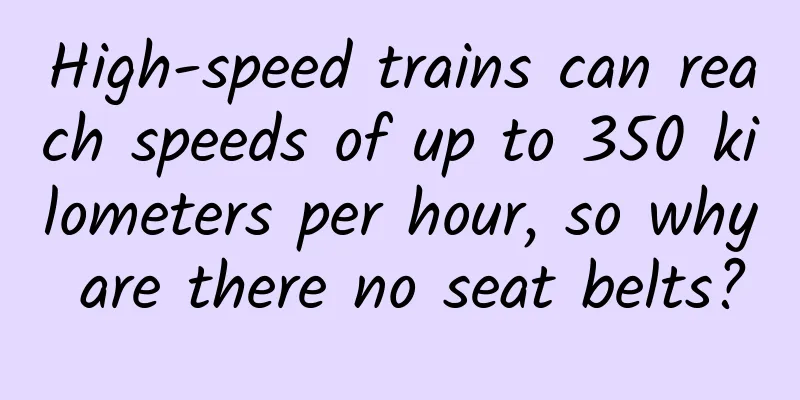High-speed trains can reach speeds of up to 350 kilometers per hour, so why are there no seat belts?

|
Nowadays, people generally have a high level of safety awareness. For example, they fasten their seat belts before driving, because seat belts can greatly ensure our life safety in the event of an accident. According to statistics, the death rate of accidents caused by not wearing seat belts is 37.7 times that of wearing seat belts. Therefore, the traffic law stipulates that drivers and passengers must wear seat belts during driving, and not wearing seat belts will result in penalty points and fines. Seat belts in cars In addition, airplanes are also one of the means of transportation equipped with seat belts. Before the plane takes off, the staff will remind passengers one by one to fasten their seat belts to prevent accidents. However, when we take the high-speed train which travels much faster than cars, we don’t need to wear seat belts. Why is that? Why do we need seat belts in cars and airplanes? When we learn to drive, take a driver's license test, and travel in daily life, we often hear the phrase "Please fasten your seat belt when driving." When we are on an airplane, the flight attendants will also supervise and remind us to fasten our seat belts. So why do we need to fasten our seat belts when we are on a car or airplane? The main purpose of installing seat belts in cars is to prevent secondary collisions. When a car collides or encounters an unexpected emergency brake, a huge inertial force will be generated, causing the driver and passengers to collide with the steering wheel, windshield, seat backs and other objects in the car for a second time, which can easily cause serious injuries to the occupants. The huge centrifugal force may even throw the occupants out of their seats or out of the car. Seat belts can restrain drivers and passengers in their seats to prevent secondary collisions, and their cushioning effect can absorb a large amount of kinetic energy and reduce the degree of injury to drivers and passengers. The role of seat belts in car accidents The seat belts designed for airplanes are mainly to prevent air turbulence. When an airplane is flying in the air, it is not like a train that can run stably on the track, so the situations it encounters are more complicated. The acceleration changes during takeoff and landing may cause the human body to passively move forward and backward, and complex climate changes may cause the airplane to violently turbulent up and down. These situations require the protection of seat belts. In severe cases, the strong turbulence that rotates up and down will throw passengers who are not wearing seat belts to the ceiling of the aircraft and then onto their seats or the floor. The danger can be imagined, so seat belts are required on airplanes. Aircraft take-off process Why are there no seat belts on high-speed rail seats? Since seat belts can protect us and reduce injuries, why aren't seat belts installed on high-speed trains? The main reasons are as follows: 1 High-speed rail has good stability When the high-speed train starts, whether you are chatting with friends or looking down at your phone, if the scenery and light outside the window do not change rapidly, you may not realize that the train has started. Many passengers have done stability tests such as standing coins, cigarettes, and building blocks on high-speed trains with speeds exceeding 350 kilometers per hour. Coins on the high-speed rail The first and foremost important reason why this can be achieved is that the operation and travel of high-speed rail relies on ballastless tracks. Here, "ballast" means small pieces of stone. As we know, conventional railways are built on a foundation composed of small pieces of stone, and then sleepers or concrete sleepers are laid, and finally rails are laid. This kind of track is called ballasted track. However, this kind of track is not suitable for high-speed trains. Ballastless track is a track structure that uses concrete, asphalt mixture and other integral foundations to replace gravel. Ballasted track vs ballastless track It can avoid ballast splashing to the greatest extent, and has good smoothness, high stability, long service life, and can support trains running at speeds of up to 350 kilometers per hour. At the same time, the ballastless track itself is relatively straight, with a large curve radius and basically no small curves, which can ensure that the train can basically move forward in a straight line without large lateral or longitudinal vibrations. So under normal circumstances, you can walk freely on the train without having to keep yourself fixed in your seat. 2 Seat belts are a deadly hazard The European Railway Safety and Standards Committee has found through a large number of investigations that passengers who are strapped to their seats are more likely to be injured in a major train accident. This is mainly because passengers who are strapped to their seats by seat belts are more vulnerable to injuries caused by the collapse of the carriage structure because they cannot effectively avoid it. In addition to rear-end collisions, trains may also have some dangerous accidents that we are not aware of , such as fire. Once a fire occurs, it spreads very quickly. Therefore, when the train stops in time, people also need to evacuate quickly. The seat belt, which is usually used to protect us, may become a "life belt" at this time, affecting the escape speed of passengers. From this point of view, the use of seat belts on high-speed trains has more disadvantages than advantages. Safety facilities on high-speed rail Although there are no seat belts installed on high-speed rails, there are safer protection facilities on high-speed rails - safety anti-collision seats. Safety seats on Fuxing trains It is designed to ensure that when the head or knee of the rear passenger hits the seat back forward, it will collapse and deform in time to prevent the passenger from being trapped. This allows the passengers to escape immediately after an accident. Based on this feature, the seat fabric is generally made of leather and textile materials. In addition, the fabric of the high-speed rail seat also has good flame retardancy to prevent fires in closed carriages with dense traffic. Planning and production Source丨Like Popular Science (id:lxkp_cstam) Editor: Yang Yaping Proofread by Xu Lailinlin |
<<: Is liposuction really safe? You will understand after reading this!
>>: “Moonquake”, is it an earthquake on the moon?
Recommend
TV also has "toxic milk powder" TV version of "Hero's Sword" first test
Image Quality: operate: Sound Effects: Plot: Expe...
What is the price for Weifang Lighting Mini Program investment? Weifang lamps mini program investment price inquiry
How much is the investment price for Weifang Ligh...
What should operators do before and after the App is released?
This article is my own summary, which is suitable...
How to make a spoken video on Douyin? What are the ways to monetize Tik Tok?
This article mainly introduces how to make a spok...
The reason why the community cannot be played may simply be because people don’t know each other!
This article is suitable for the following audien...
96% of the people who took the physical examination were detected with long-term COVID-19 antibodies? Should I also take the test?
Recently, many places across the country have off...
Why do my eyes feel uncomfortable when I look at the computer at work?
As we all know, eyes are called "windows to ...
Three questions about knowledge payment: How to monetize? User retention? Content operation?
Wu Bingjian : I have invested in a knowledge paym...
Are the small fragments picked off from the teeth a sign of tooth damage?
gossip “Sometimes you can pick off small pieces o...
User operation: AARRR user model and traffic pool model explained in detail!
1. What is the AARRR user analysis model? AARRR i...
Six steps! Crack and install Media Center in Windows 10
Microsoft completely cancelled the previous Windo...
Gou Wenqiang's "31 Posture Correction Training Camp" will give you a perfect body
Introduction to the training course content: In 7 ...
How can products improve user stickiness? Here are 3 tips
These people used to be our customers, but they d...
Soul product operation analysis report
In today's society where the Internet is wide...
Practical review! Skills to win a BAT group interview with just six sentences
Group interviews, also known as leaderless group ...









